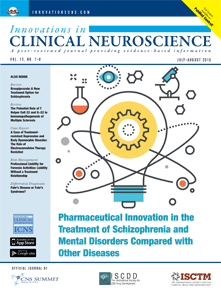Welcome to the July–August 2016 issue of Innovations in Clinical Neuroscience. We start this issue with an interesting study by MacEwan et al titled, “Pharmaceutical Innovation in the Treatment of Schizophrenia and Mental Disorders Compared with Other Diseases.” Here, the authors assessed the level of private and public investment in research and development (R&D) of treatments for schizophrenia and other mental disorders and compared this to other diseases. They present their data on the economic burden and pharmaceutical innovation by disease area and compare the level of investment relative to burden across different diseases. Perhaps not surprisingly, the authors found the level of investment and pharmaceutical innovation in mental disorders to be comparatively low, especially relative to the burden of disease. The authors discuss potential reasons for this lack of investment and innovation. How this problem can be resolved requires further elucidation.
Next, Scarff provides a brief review of brexpiprazole, a new treatment option for schizophrenia. Based on the published studies, he describes the drug’s mechanisms of action, efficacy, tolerability (including adverse effects), dosing, and contraindications.
Following this, in a review article by Fard et al titled, “The Potential Role of T Helper Cell 22 and IL-22 in Immunopathogenesis of Multiple Sclerosis” the authors discuss the newly identified T helper cell 22 (Th22), a subset of CD4+ T cells, and the potential impact its function and gene expression may have on the immunopathogenesis of multiple sclerosis (MS). The authors describe several studies that have demonstrated changes in frequency and function of Th22 in patients with MS and how this may be significant to the development of new therapeutic strategies for treating MS and other neuro-inflammatory diseases.
Next, Mahato et al present their case report title, “A Case of Treatment-resistant Depression and Body Dysmorphic Disorder: The Role of Electroconvulsive Therapy Revisited.” Here, the authors describe the case of a 50-year-old woman with treatment-refractory major depressive disorder (MDD) and comorbid body dysmorphic disorder (BDD) who experienced a two-month remission of both disorders following a trial of electroconvulsive therapy (ECT). While studies have supported the use of ECT in managing the depressive symptoms in individuals with comorbid MDD and BDD, studies have not shown it to be effective in reducing the dysmorphic symptoms. Though remission of MDD and BDD symptoms in the authors’ case was not maintained beyond two months, the authors believe that, in select cases, ECT may be an effective treatment for dysmorphic symptoms in individuals with comorbid MDD and BDD and that additional research is warranted.
We wrap the issue up with this month’s installment of “Risk Management,” in which Vanderpool reviews the legal risks associated with performing independent medical examinations (IMEs) in the forensic setting. We also present a brief checklist contributed by Perugula and Lippmann that’s designed to help clinicians distinguish between Fahr’s disease and Fahr’s syndrome. In the coming months, be on the lookout for a few more of these “Differential Diagnoses” checklists that will compare various neurological conditions that pose differential challenges in diagnoses.
We hope you enjoy the issue. As always, we welcome your feedback and submissions.
Sincerely
Amir Kalali, MD
Editor, Innovations in Clinical Neuroscience






